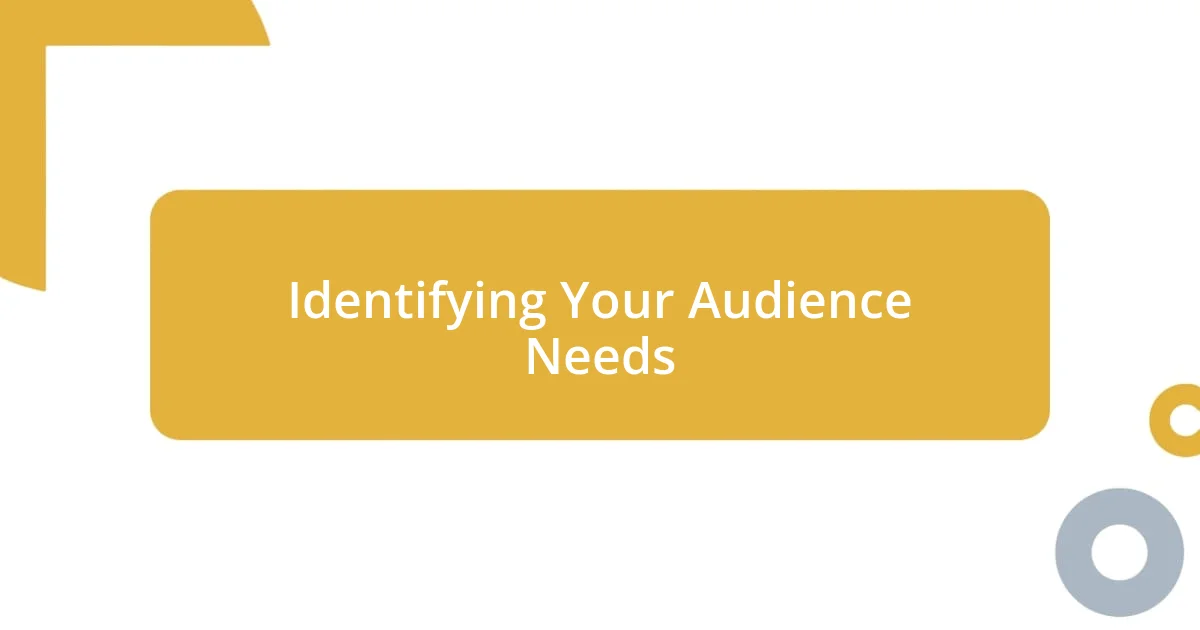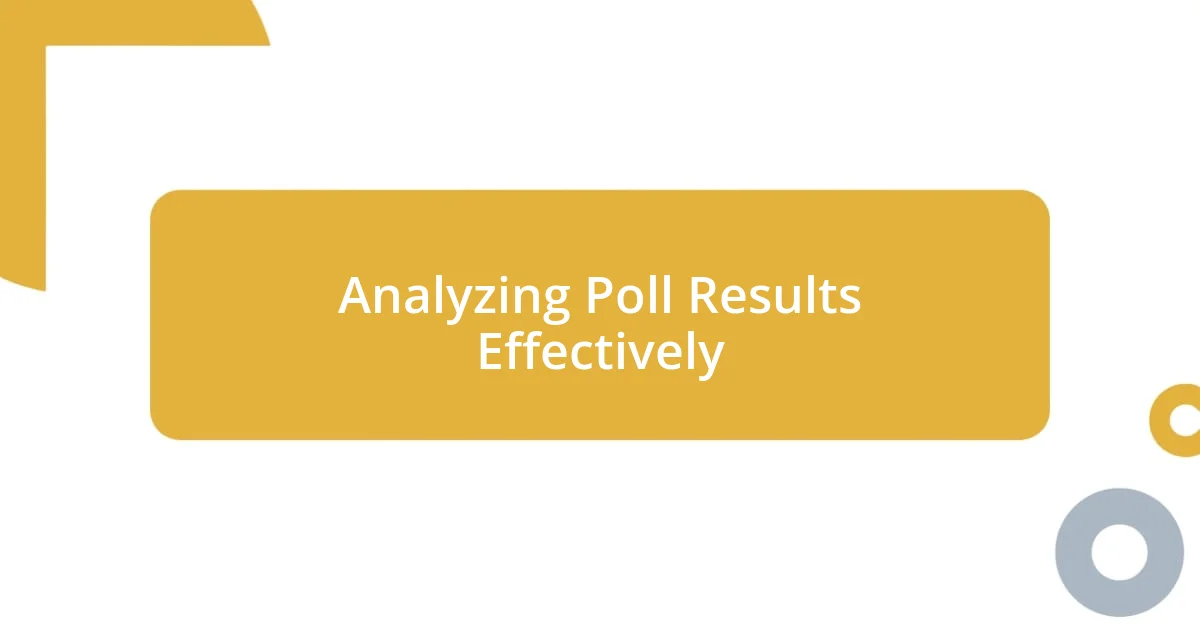Key takeaways:
- Polls effectively engage audiences by sparking conversations and fostering a sense of community through relatable and emotional questions.
- Understanding audience demographics and preferences is crucial for crafting relevant poll questions, which enhances engagement and response quality.
- Analyzing poll results informs content creation, allowing for content that aligns with audience interests and encourages ongoing dialogue and trust.

Understanding the Power of Polls
Polls possess a unique ability to not only gauge opinions but also to ignite conversations. I remember the first time I ran a poll on social media; the response was overwhelming! The relatability of those questions made my audience feel involved, like they were part of something larger.
Every time I utilize a poll, I can see firsthand how it bridges the gap between topics and the people I’m engaging with. It’s fascinating to think about how a simple question can spark a heated debate or a shared laugh. Have you ever noticed how polls can create an immediate sense of community?
What strikes me most is the emotional gravity that polls hold. They invite people to voice their views, creating an atmosphere of inclusiveness. For instance, when I asked about preferences in a recent project, the diverse responses not only fueled my creativity, but they also highlighted the varied experiences and insights my audience carries. Isn’t it incredible how just one question can open up such rich dialogues?

Identifying Your Audience Needs
Identifying the needs of your audience is critical in shaping how polls resonate with them. I often start by reflecting on my past interactions. Recently, I discovered that most of my followers are interested in specific topics, like sustainability. By tailoring my polls to those interests, I found that they were not just more engaged but also more willing to share their thoughts. It’s like standing in a room full of people; when you start a conversation about something they care about, suddenly, everyone wants to join in.
Understanding demographic factors also plays a huge role in identifying audience needs. For instance, I noticed a stark difference in responses when I targeted younger audiences compared to older ones. Younger people tend to be more open to discussing trends and technology, while older audiences often prefer topics around family and tradition. This realization has guided me in crafting questions that not only resonate with the different groups but also ignite rich discussions among them.
Lastly, don’t underestimate the value of feedback. After conducting a series of polls, I posted a follow-up asking participants what they’d like to see next. The flood of suggestions was enlightening! It showed me that they valued my input and were eager to share their ideas. That’s where the magic happens—creating an ongoing dialogue establishes trust and keeps the conversation alive.
| Demographic | Interests |
|---|---|
| 18-24 | Technology, Trends |
| 25-35 | Career Development, Travel |
| 36-50 | Family, Home Improvements |
| 51+ | Tradition, Hobbies |

Crafting Engaging Poll Questions
Crafting engaging poll questions is an art, and I’ve found that the more specific I am, the better the responses. I recall a time I asked a broad question about favorite foods; the answers were all over the place. But when I rephrased it to focus on “What’s your go-to comfort food on a rainy day?” engagement skyrocketed. That simple tweak made my followers reflect their personal experiences, sparking an array of heartfelt stories and shared connections.
Consider these tips for crafting engaging poll questions:
- Be relatable: Ask questions that resonate with your audience’s everyday experiences.
- Keep it concise: Short, clear questions are easier for respondents to answer.
- Use vivid scenarios: Frame situations that encourage deeper thought, like “If you could only eat one dessert for the rest of your life, what would it be?”
- Encourage emotional responses: Tap into feelings or memories that can elicit passionate answers.
- Incorporate humor: A light-hearted approach can invite more engagement and laughter among participants.
Each time I implement these strategies, the dialogue becomes richer, and I feel a deeper connection with my community. It’s those emotional cues that transform simple polls into engaging conversations I genuinely look forward to.

Choosing the Right Polling Tools
When it comes to choosing the right polling tools, I always consider the user experience first. For example, I tried a couple of tools that appeared visually appealing but ended up being cumbersome to navigate. I want my audience to engage easily, without hitting roadblocks, so I usually stick to platforms that are intuitive and straightforward.
Another aspect I prioritize is versatility. I recall testing a polling tool that allowed me to customize questions and options extensively, but it lacked integration with my other social media platforms. It felt like having a fancy car with no roads to drive on! So, I always look for tools that seamlessly fit into my existing workflow, allowing me to reach my audience where they already gather.
Lastly, analyzing the analytics these tools provide is essential for me. There was a time I used a tool with limited analytics, and I regretted not being able to gauge the true impact of my polls. The insights from robust analytics can reveal which topics truly resonate, guiding me toward future polls that can spark even more interest. Choosing a tool that offers comprehensive data not only enhances my understanding but also fuels my creative process for more engaging questions.

Promoting Your Poll for Engagement
Promoting your poll effectively can make a world of difference in the level of engagement you achieve. I remember one time when I had an exciting poll ready, but I didn’t promote it well, and the responses were lackluster. I realized that sharing it across various platforms—like Instagram Stories and Twitter—created buzz and drew in participants who otherwise might not have seen it. It’s all about maximizing visibility.
Timing is also crucial when promoting your poll. I’ve noticed the best times to post are when my audience is most active online, often during breaks or in the evenings. One memorable poll I had on weekend plans caught fire because I posted it right around lunchtime on Friday, sparking a conversation about exciting weekend adventures. Engaging with people in real-time can transform mere feedback into a lively discussion.
Lastly, I encourage my audience to share their opinions on my polls and even swap them with friends. The moment I started inviting my followers to tag someone they know would enjoy participating, my polls gained a new layer of energy. It’s fascinating how personal connections drive participation. Have you ever thought about how a simple invitation can turn a solitary activity into a social one? It has a remarkable way of amplifying engagement and breathing life into the discussions.

Analyzing Poll Results Effectively
When analyzing poll results, I pay close attention to the data trends that emerge. I’ve experienced the excitement of discovering a surprising favorite topic among my audience, which often leads me to dig deeper into why that particular choice resonated so much. It’s like piecing together a puzzle that reveals what truly connects with my followers, transforming raw numbers into meaningful conversations.
One effective strategy I’ve found is segmenting the responses. For instance, I’ll often break down results based on demographics, like age or location, to uncover unique perspectives. I still remember glancing at a poll that showed a distinct preference among younger participants for interactive content versus older ones favoring straightforward information. This not only guided my future polls but also made me realize the vast diversity within my audience. Have you ever come across unexpected insights that changed your approach?
Finally, I’m always mindful of the feedback loop created by analyzing and responding to the results. A heartfelt message I received after sharing my takeaways from a poll warmed my heart—it showed my audience that their opinions were valued and heard. Returning to those insights can fuel dynamism in my content, encouraging ongoing dialogue. Reflecting on how your audience feels after participating can be a game-changer, don’t you think? It creates a sense of community that fosters deeper engagement and trust.

Applying Insights to Future Content
After gathering insights from my polls, I’ve found it immensely helpful to create content that directly reflects what my audience wants. For instance, after one poll revealed a keen interest in mental health strategies, I crafted a series of posts addressing specific coping techniques. I felt a genuine connection with my readers when they expressed how those tips had helped them. Isn’t it rewarding to see your content resonate deeply with others?
I also believe in the importance of testing new content themes inspired by poll responses. Once, after a particularly engaging poll about favorite learning methods, I decided to host a webinar on the most popular techniques. It struck me how participants eagerly joined, sharing their experiences and insights in real-time. Have you considered how tapping into your audience’s preferences can lead to richer content experiences?
Another key aspect is iterating on this feedback and showing my audience that their input shapes the direction of my content. I remember receiving a message from a follower who said the changes I made based on polls encouraged them to engage more actively with my posts. It’s moments like these that remind me how powerful it is to listen to our audience. Isn’t it fascinating how that feedback loop can transform not just your content, but your relationship with your followers?












